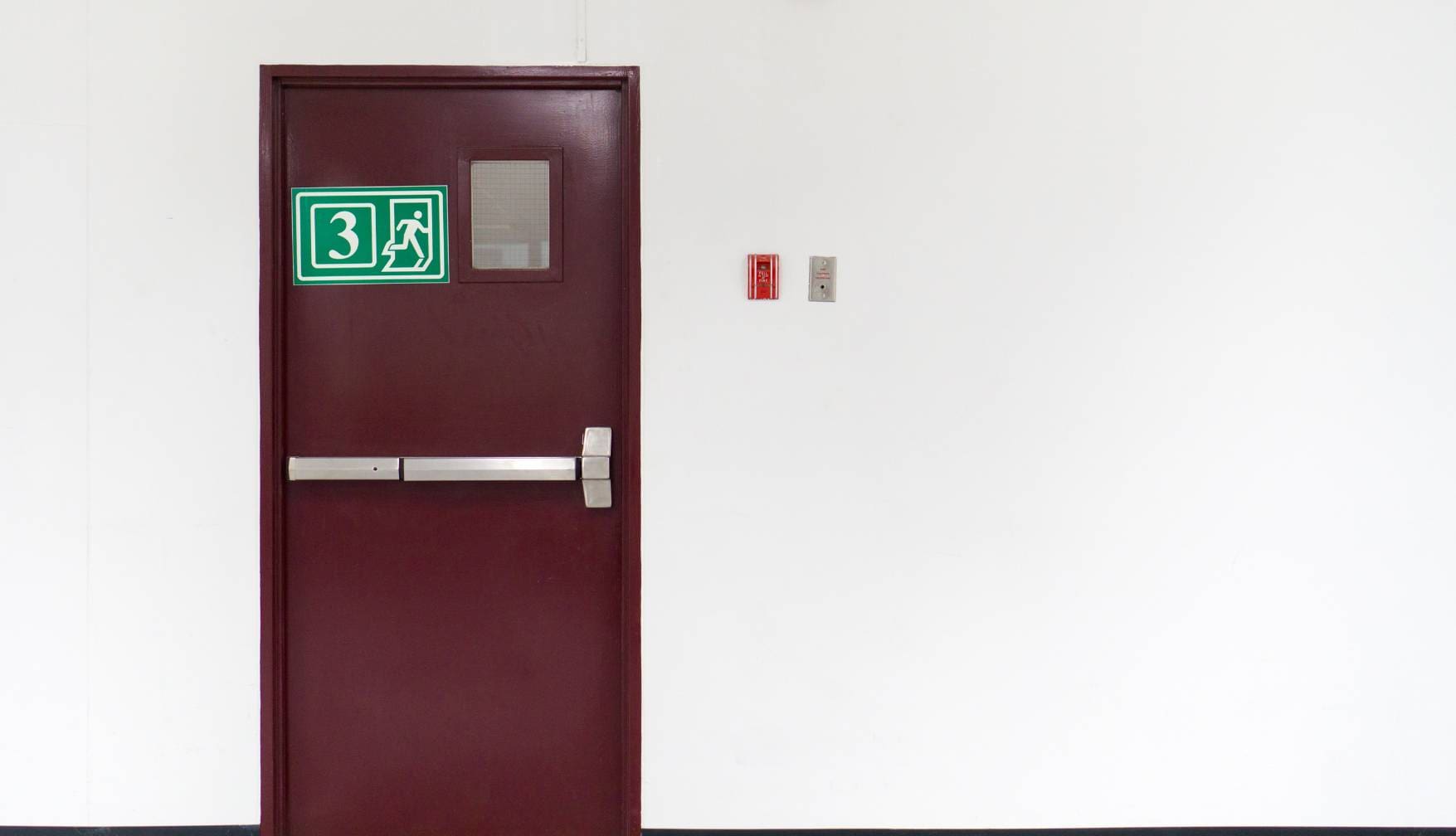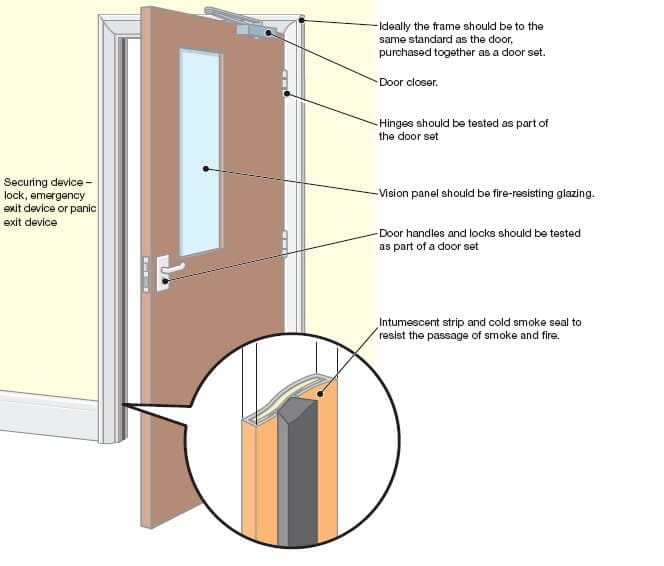Fire Door Inspection and Compliance

What is a Fire Door?
A fire-resisting door is often referred to as a fire door which, together with its frame and hardware, allows for the movement of people and goods within a fire compartment wall. A closed fire door restricts fire and the passage of smoke to a predictable level of performance.
A complete installed fire door assembly typically comprises of:
- Door frame
- Door leaf
- Seals
- Ironmongery (Hinges, Lock/latch, Door closer)
- Glazing (if present on fire door assembly)
The full installed assembly must be tested and certified as a complete entity if the fire door set comes from the same source. If these components are provided individually from one or more sources, separate test evidence must be provided.
No door on its own is fire rated and should never be inspected as such. The complete fire door set provides adequate fire rating (i.e. FD30 or FD60 depending on test evidence). The safety of a fire door cannot be guaranteed if one component is introduced, which is not certified or tested.
The Importance of a Fire Door in a Building’s Fire Safety Strategy
Fire doors should be tested against the elements to ensure they are purpose-built to withstand a fire for as long as possible. A fire door’s main purpose is to enable buildings to compartmentalise, delaying the spread of fire.
Door openings in fire or compartment wall are required to be fire doors in accordance with the standard indicated in Table B1 of TGD B. Fire doors must achieve the designed fire rating (i.e FD30 or FD60), depending on the fire rating of the fire wall or compartment wall.
Fire doors vital safety features can be the difference between life and death. The most important functions of fire doors are:
- Form a barrier to stop the spread of fire when closed.
- Provide a means of escape when open.
CE Certification
All construction products on the EU market must be CE marked. The following hardware products are required to be CE marked if intended for use in fire-resisting doors:
- Single point locks and electromechanical locks.
- Single-axis hinges.
- Controlled door closing devices.
- Electrically door closing devices.
- Door co-ordinator devices.
Anyone supplying these products will need to ensure that:
- A notified product certification body has issued a certificate of constancy of performance.
- A declaration of performance (DoP) has been issued.
- The CE marking has been applied.
A fire door must have documented evidence of performance. This can be in form of:
- Single test report
- Multiple test reports
- An assessment issued by an organisation which are accredited.
- Third party product certification.
In order to comply with Building Regulations fire doors are currently tested as a complete door assembly to standard BS476 Pt22 or BS EN 1634-1. A test report is NOT a certificate. It is an evaluation of what happened under testing laboratory conditions.
Fire Door Inspection Compliance
Non-compliance issues in relation to the installation of fire door set assemblies range from existing doors to newly installed fire door sets. Criteria we look for when completing inspections on fire door assemblies which need to be maintained to achieve compliance include:
- Fire door frames should not be accepted if they are less than 30mm thick for FD 30S doors and 44mm thick for FD60S doors unless accompanied by evidence of performance.
- Typically frame and threshold gaps acceptable are 3mm+/- 1mm at door to frame and 8-10mm at the threshold from the floor covering to door unless a smoke seal is present. This can only be disregarded if specified on the test certificate.
- If the frame or threshold gaps exceed the acceptable requirements, they must be remedied as the performance of the fire door is compromised and will not serve its purpose.
- Any component in door leaf (i.e glazing, letterboxes, or transfer grilles) must have appropriate test evidence to the required standard to demonstrate suitable integrity of performance when installed in the fire door set.
- Glazing in doors and screens must comply with minimum impact safety requirements. Glass should be marked to advise its rating typically 30 or 60 minutes tested to EN 1634-1.
- Any gaps between the rear of the frame and the wall must be fire sealed using a fire tested fire joint design with evidence of performance (i.e intumescent mastic and correct depth to width ratio) Fire rated foam can only be used if backed up by suitable evidence of performance.
- All fire door hardware must be CE marked. A fire door must have an automatic closing device while it has to permit the flow of traffic during everyday use it must self-close in the event of a fire.
- A fire door must be identifiable, fire doors should carry an appropriate sign such as ‘Fire Door Keep Shut’, and all fire doors should remain unobstructed. All signage to comply with BS 5499-10:2014.
- All fire doors components should have identification tags to record manufacturers details. All fire doors should have a metal identification tag and should not be painted over.
- All properties should keep a record of regular inspections and maintenance of fire doors to comply with current regulation but most importantly to keep people and the property safe. It is advisable to keep all records in the properties fire safety manual.
The Importance of Fire Door Inspections
It is imperative that fire doors receive regular inspections. Frequency is likely to depend on many factors, including the age and condition of the door. It has been suggested that a minimum quarterly inspection rule may be applied.
Five areas to check when inspecting fire doors:
- Certification : Look for a label or plug on top of the door to ensure the actual door is a fire door.
- Gaps: Check gaps are acceptable for fire door compliance. Typically frame and threshold gaps acceptable are 3mm+/- 1mm at door to frame and 8-10mm at the threshold from floor covering to door unless a smoke seal is present. This can only be disregarded if specified on the test certificate.
- Seals: Look for any intumescent seals around door or frame. Check they are intact with no sign of damage. Seals are required to expand in contact with heat in the event of a fire.
- Hinges: Check all three hinges are firmly fixed with no missing screws. Be sure the door has been properly maintained and will perform in the event of a fire.
- Closing Properly: Check door closes firmly onto the latch without sticking on the floor or frame. A fire door only serves its purpose when it can operate to a close position.
If you would like to discuss Fire Safety requirements for your project, please get in touch with Seán Fay from the ORS Fire Safety Team.

